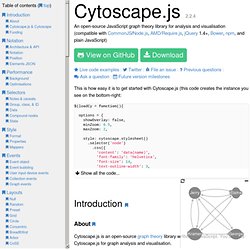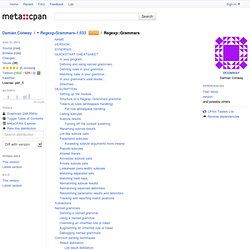

Cytoscape.js. This is how easy it is to get started with Cytoscape.js (this code creates the instance you see on the bottom-right: About Cytoscape.js is an open-source graph theory library written in JavaScript.

You can use Cytoscape.js for graph analysis and visualisation. Cytoscape.js allows you to easily display and manipulate rich, interactive graphs. Because Cytoscape.js allows the user to interact with the graph and the library allows the client to hook into user events, Cytoscape.js is easily integrated into your webapp, especially since Cytoscape.js supports both desktop browsers, like Chrome, and mobile browsers, like on the iPad. Cytoscape.js also has graph analysis in mind: The library contains a slew of useful functions in graph theory.
Cytoscape.js is an open-source project, and anyone is free to contribute. The library was developed at the Donnelly Centre at the University of Toronto. Cytoscape.js & Cytoscape Funding Funding for Cytoscape.js and Cytoscape is provided by NRNB (U.S. Notation.
PhoneGap. Android. Grammars - Add grammatical parsing features to Perl 5.10 regexes. Regexp::Grammars - Add grammatical parsing features to Perl 5.10 regexes This document describes Regexp::Grammars version 1.033 In your program...

Defining and using named grammars... Defining rules in your grammar... Matching rules in your grammar... In your grammar's code blocks... Directives... This module adds a small number of new regex constructs that can be used within Perl 5.10 patterns to implement complete recursive-descent parsing. Perl 5.10 already supports recursive=descent matching, via the new (?
This technique makes it possible to use regexes to recognize complex, hierarchical--and even recursive--textual structures. An additional problem when using Perl 5.10 regexes to match complex data formats is that you have to make sure you remember to insert whitespace-matching constructs (such as \s*) at every possible position where the data might contain ignorable whitespace. The Regexp::Grammars module solves both those problems. Setting up the module Just add: to any lexical scope.
J Home. J Home. jQl an asynchronous jQuery Loader - yterium.net. “Put javascript at bottom”… or not ?

One good practice in web performance optimization is to “put script at bottom”. The reason is that while scripts are loading, most browsers block others components from loading. When you put your scripts at the bottom of the HTML document, all components can be loaded without delay, and, in the end, scripts can be loaded. However, doing this way has some drawbacks : One is that the loading of externals scripts is delayed after all other components. I’ve been wondering for a long time if it would be possible to get rid of these drawbacks while reaching the following goals: early external jQuery loading non blocking jQuery loading that allow other components on the same page to be loaded in parallel, including jQuery plugins non blocking inline script in the HTML document, that could call jQuery('document').ready(), even when jQuery and its plugins havent’ been loaded yet. jQl is my solution. jQl an inline loader Asynchronously loading jQuery jQl.loadjQ('
Home : Official Microsoft Site.